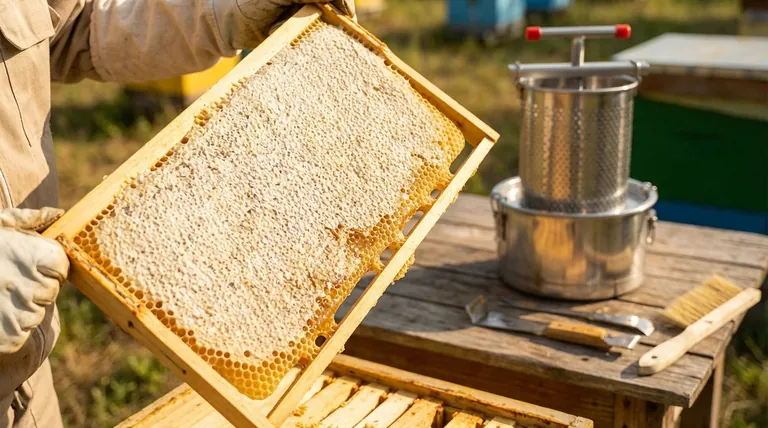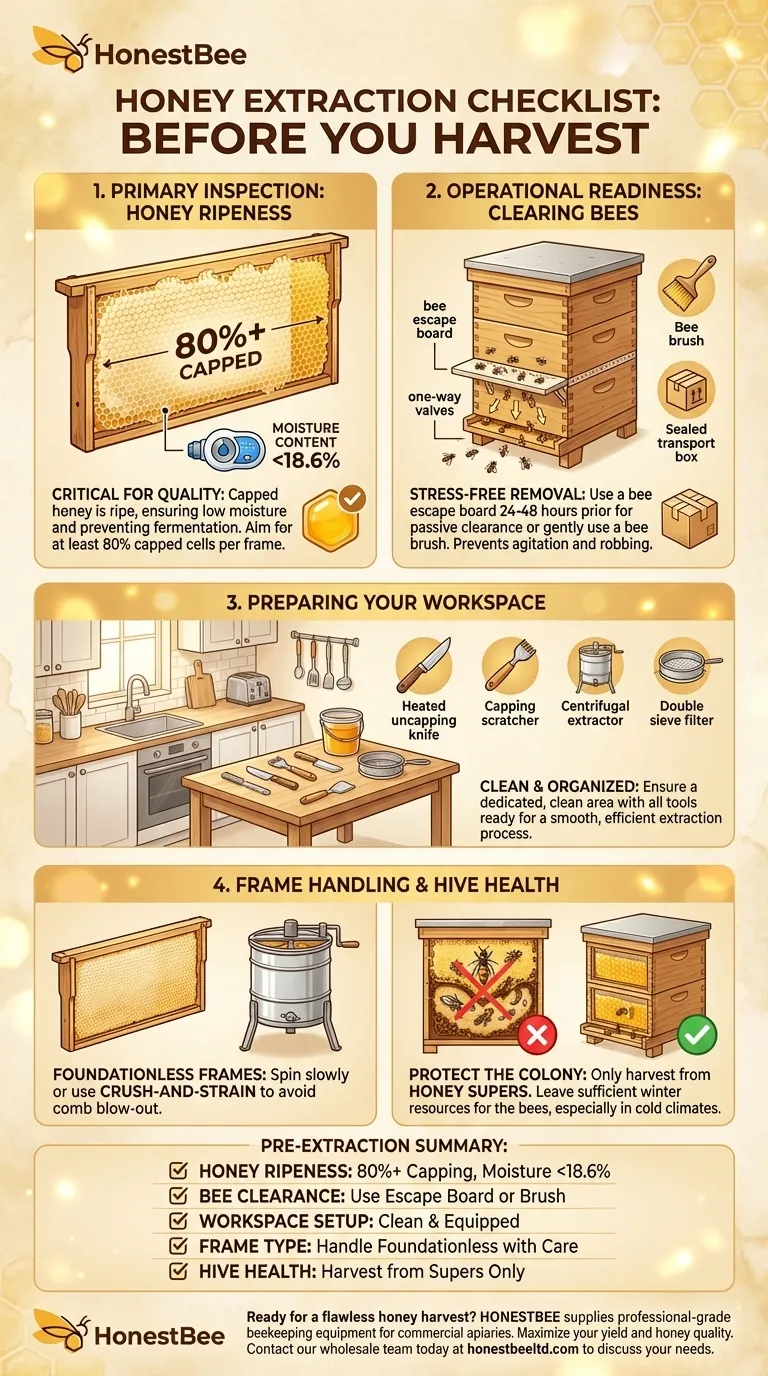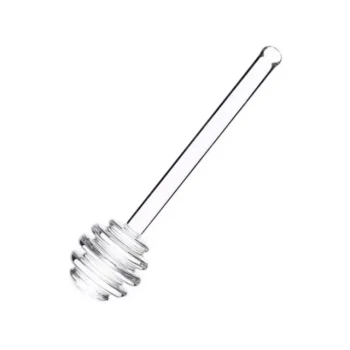Before any honey is extracted, the most critical inspection is to verify that the honeycombs are "capped." A frame that is at least 80% covered with a fresh, white-yellow wax capping indicates the honey is ripe, meaning the bees have naturally dehydrated it to the correct moisture content (below 18.6%). Harvesting uncapped or "green" honey risks fermentation and spoilage of your entire batch.
Successful honey extraction is not a single action but a systematic process. True readiness involves assessing honey ripeness, preparing your equipment and workspace, and managing the bees and frames in a way that protects both the quality of your honey and the health of your colony.

The Primary Inspection: Is the Honey Ripe?
The first and most important step is a visual inspection of the frames inside the honey super. This determines whether the bees have finished their work.
What to Look For: Capped Honey
Capped honey is sealed in its hexagonal cell by a wax covering. This capping is the bees' signal that the honey is cured and ready for long-term storage.
It appears as a dry, whitish or light-yellow layer over the comb, distinct from the wet, glistening appearance of uncapped honey.
The 80% Rule
A single frame is considered ready for extraction when at least 80% of its cells are capped.
While you may see some uncapped cells, especially around the edges, a frame that is predominantly capped is a reliable indicator that the overall moisture content is sufficiently low. If a super has ten frames, you should aim for at least seven or eight of them to meet this 80% threshold before pulling them for harvest.
Why Moisture Content is Critical
Bees beat their wings to evaporate water from the nectar until it becomes honey, a supersaturated sugar solution. They cap it only when the moisture level is low enough to prevent wild yeast from fermenting it.
Extracting honey with high moisture content (uncapped honey) will almost certainly lead to fermentation, giving the honey an off-taste and causing it to spoil.
Preparing for a Smooth and Clean Extraction
Once you've confirmed the honey is ripe, your focus shifts to operational readiness. A chaotic extraction process stresses bees and compromises honey quality.
Clearing Bees from the Frames
You must remove the bees from the honey frames before bringing them indoors. A bee brush can be used to gently sweep bees off each frame, but this can be slow and may agitate the colony.
A more passive and effective method is to use a bee escape board. This one-way door is placed between the honey supers and the brood boxes 24-48 hours before extraction, allowing bees to move down into the hive but not back up.
Securing the Harvest
Once the frames are free of bees, place them immediately into a sealed, bee-proof box for transport.
This simple step is crucial for preventing "robbing," a frenzy where bees from your hives (or neighboring ones) discover the exposed honey and attempt to steal it, which can lead to a defensive and agitated apiary.
Preparing Your Workspace
Your extraction area—whether a dedicated "honey house" or a clean kitchen—should be set up before you bring the frames inside.
Ensure all surfaces are clean and that your tools are laid out and ready. This includes your uncapping knife, a capping scratcher for any missed cells, the extractor, and a filtering system (like a double sieve) to strain the honey.
Understanding the Trade-offs and Potential Pitfalls
Every decision in beekeeping involves trade-offs. Understanding them allows you to avoid common mistakes that can compromise your harvest or hive health.
The Risk of Extracting Uncapped Honey
While tempting, harvesting significant amounts of uncapped honey is a major pitfall. The resulting high moisture content will spoil your harvest. If you must extract frames with uncapped sections, keep them separate from your main batch.
Handling Foundationless Frames
Frames without a plastic or wax foundation require special care. The comb is more fragile and can "blow out" from the centrifugal force of the extractor.
When spinning foundationless frames, start the extractor very slowly to allow some of the heavy honey to be flung out first. Gradually increase the speed as the frame becomes lighter. Alternatively, the crush-and-strain method is a practical and safe option for these frames.
The Impact on the Colony
Remember that honey is the bees' winter food source. Avoid harvesting from the brood boxes where the queen lays eggs and the colony raises its young.
Only harvest from the designated honey supers, and always ensure you leave enough resources for the bees to survive the off-season, especially in colder climates.
Making the Right Choice for Your Goal
Your approach to extraction should align with your specific beekeeping objectives.
- If your primary focus is maximum honey quality: Prioritize fully capped frames and consider using a refractometer to verify moisture content is below 18.6%.
- If your primary focus is efficiency at a larger scale: Invest in a bee escape board for clearing supers and a heated uncapping knife to speed up the workflow.
- If your primary focus is natural or small-scale beekeeping: Consider the crush-and-strain method, especially with foundationless frames, as it allows you to harvest valuable beeswax alongside your honey.
By approaching honey extraction as a deliberate and well-prepared process, you ensure a high-quality product while stewarding the long-term health of your hives.
Summary Table:
| Pre-Extraction Check | Key Action | Why It Matters |
|---|---|---|
| Honey Ripeness | Inspect for 80% white-yellow wax capping. | Indicates honey is ripe (moisture <18.6%), preventing fermentation. |
| Bee Clearance | Use a bee escape board or brush to remove bees. | Prevents agitated bees and robbing during harvest. |
| Workspace Setup | Prepare uncapping knife, extractor, and filters. | Ensures a smooth, clean, and efficient extraction process. |
| Frame Type | Handle foundationless frames with extra care. | Avoids comb blow-out in the extractor; crush-and-strain is an option. |
Ready for a flawless honey harvest? HONESTBEE supplies commercial apiaries and beekeeping equipment distributors with the professional-grade tools needed for every step—from bee escape boards and heated uncapping knives to high-capacity extractors. Let our wholesale-focused expertise help you maximize your yield and honey quality. Contact our team today to discuss your equipment needs and streamline your operation.
Visual Guide

Related Products
- Stainless Steel Honey Press Wax Press with Tank
- Stainless Steel Manual Honey Press with Guard for Pressing Honey and Wax
- Electric Flatting and Embossing Machine with Tray for Beekeeping
- Honey Wax Separating Wax Press with Metal Screw Wax Separator Machine
- Professional Wide Blade Honey Scraper for Beekeeping and Honey Processing
People Also Ask
- How does pressed honey compare to extracted or crush-and-strain? Unlock the Full Flavor of the Hive
- What happens to the wax after pressing in a honey press? A Guide to Maximizing Your Hive's Yield
- What are the key features of a honey press? Maximize Yield with Durable, Efficient Extraction
- How do you press honey out of a comb? A Simple Guide to the Crush and Strain Method
- What are the benefits of the screw design in a stainless steel honey pump? Preserve Honey Quality and Integrity



















